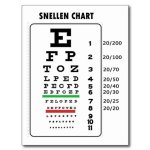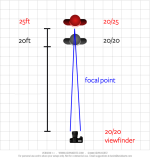Browncoat
Senior Member
I was long overdue for an eye exam. My prescription hasn't changed since my first pair of glasses in 7th grade (over 20 years ago), and my chart revealed today that I haven't been to the eye doctor since 2006. Anyway...I'm pushing 40 now, and I've been noticing some issues that I first started seeing in my photos. I use manual focus a lot, and when I get home and upload photos to my computer, I often see a slight sharpness problem. This isn't about technique or gear. I no guru, but I've been doing this long enough to know how to get a sharp photo. And that's just it: they look sharp in my viewfinder, when when I get home, they're not.
My optometrist revealed to me today that my prescription is set to 20/25, which means my focal point is at 25ft, 5ft beyond "normal" 20/20 vision. This isn't an issue for most people, and many don't know the difference or even prefer it that way, especially for driving. But because I often photograph at that distance, it has become a problem. I chose to go with a new prescription that will split the difference. Instead of 20/20 or staying with my current 20/25, I'm going with 20/22.5.
This can be corrected by adjusting the viewfinder diopter. The doctor gave me the new setting, and after making the change, it does help.
Just a public service announcement in case any of my near-sighted friends are experiencing the same thing.
My optometrist revealed to me today that my prescription is set to 20/25, which means my focal point is at 25ft, 5ft beyond "normal" 20/20 vision. This isn't an issue for most people, and many don't know the difference or even prefer it that way, especially for driving. But because I often photograph at that distance, it has become a problem. I chose to go with a new prescription that will split the difference. Instead of 20/20 or staying with my current 20/25, I'm going with 20/22.5.
This can be corrected by adjusting the viewfinder diopter. The doctor gave me the new setting, and after making the change, it does help.
Just a public service announcement in case any of my near-sighted friends are experiencing the same thing.


